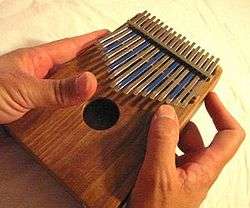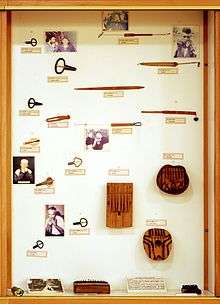Lamellophone


A lamellophone (also lamellaphone or linguaphone, from the Latin root lingua meaning "tongue", i.e., a long thin plate that is fixed only at one end) is any of a family of musical instruments.
The instrument has a series of thin plates, or "tongues", each of which is fixed at one end and has the other end free. When the musician depresses the free end of a plate with a finger or fingernail, and then allows the finger to slip off, the released plate vibrates.
The lamellophones constitute category 12 in the Hornbostel–Sachs system for classifying musical instruments, plucked idiophones. These idiophones are equipped with one or more tongues or lammelae that produce sound by being plucked by the performer. There are two main categories of plucked idiophones, those that are in the form of a frame (121) and those that are in the form of a comb (122).
African lamellophones

A large number of lamellophones originate in Africa, where they are known under different names including mbira, sanza, kisanji, likembe, kalimba, and kongoma. They play a role in southeast African Music. They were reported as early as the 16th century, but there is no doubt they have a much longer history. The Caribbean marímbula is also of this family. The marímbula can be seen as a bass variant of the mbira and is sometimes used in hiphop music.
The tongues may be arranged in the manner of a piano and may be made small enough to play with individual fingers, hence the colloquial name "thumb piano". (Although some instruments, like the Mbira, have an additional rows of tongues, in which case not just the thumbs are used for plucking.)
Some conjecture that African lamellophones were derived from xylophones and marimbas. However, similar instruments have been found elsewhere; for example, the indigenous peoples of Siberia play wooden and metallic lamellophones with a single tongue.
Lamellophones may be made with or without resonators. There are also electric lamellophones with an additional pickup.
.jpg)
Schaeffner's classification
Schaeffner's musical instrument classification scheme has a post-prominent place for the linguaphones (lamellophones) at the second highest level of classification.
In 1932, Andre Schaeffner developed a new classification scheme that was "exhaustive, potentially covering all real and conceivable instruments" [Kartomi, p. 176]. Schaeffner's system has only two top-level categories denoted by Roman numerals (Schaeffner, A.: Origine des instruments de musique, pp. 371–377.):
- I: instruments that make sound from vibrating solids;
- IA Solids not susceptibles of tension (equivalent to a big part of Hornbostel & Sachs idiophones);
- IB Flexible solids (equivalent to mainly linguaphones);
- IC Tensionable solids (equivalent to both membranophones and chordophones);
- II: instruments that make sound from vibrating air (aerophones).
List of lamellophones
In the form of a frame (121)
The lamellae vibrate within a frame or hoop
121.1 Clack idiophones or Cricri - The lamella is carved in the surface of a fruit shell, which serves as resonator.
121.2 Guimbardes and jaw harps - The lamella is mounted in a rod- or plaque-shaped frame and depends on the player's mouth cavity for resonance.
121.21 Idioglot guimbardes - The lamella is of one substance with the frame of the instrument.
121.22 Heteroglot guimbardes - The lamella is attached to the frame.
121.221 Individual heteroglot guimbardes.
121.222 Sets of heteroglot guimbardes.
In the form of a comb (122)
The lamellae are tied to a board or cut out from a board like the teeth of a comb. 122.1 With laced on lamellae.
- Array mbira
- Agidigbo
- Eleke
- Ikembe
- Kalimba
- Kasayi
- Kisanji
- Likembe
- Malimbe
- Marímbula - Caribbean thumb piano
- Mbira
- Oopoochawa
- Thumb piano
- Tom
- Sanza/Sansa
- Space Harp
- Whale Drum
- Zimbabwean Marimba
122.11 Without resonator.
122.12 With resonator.
122.2 With cut-out lamellae
See also
References
- Gerhard Kubik: "Lamellophone", in: The New Grove Dictionary of Music and Musicians (ed. Stanley Sadie). Macmillan Publishers, London, 1981
- Specific